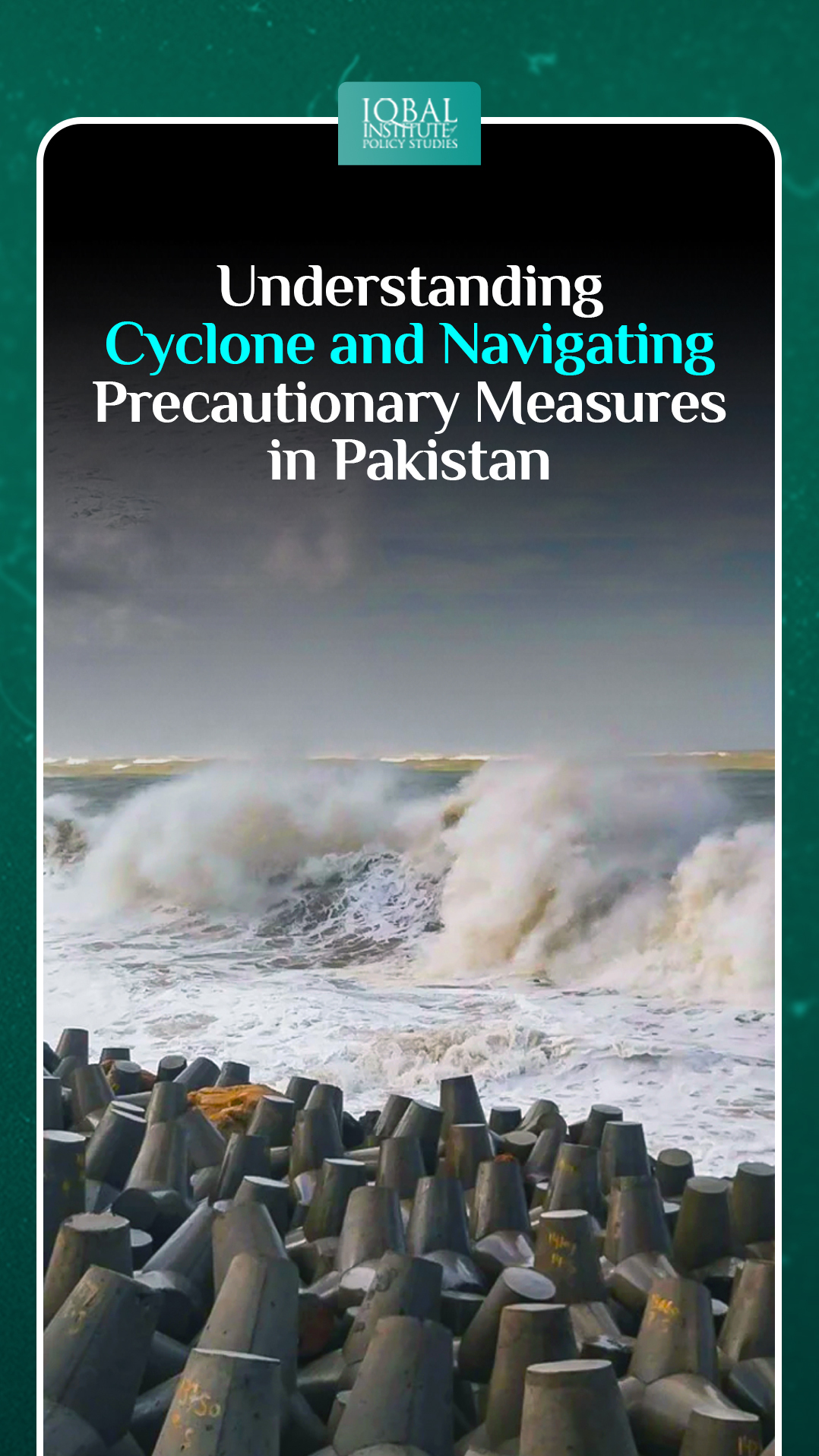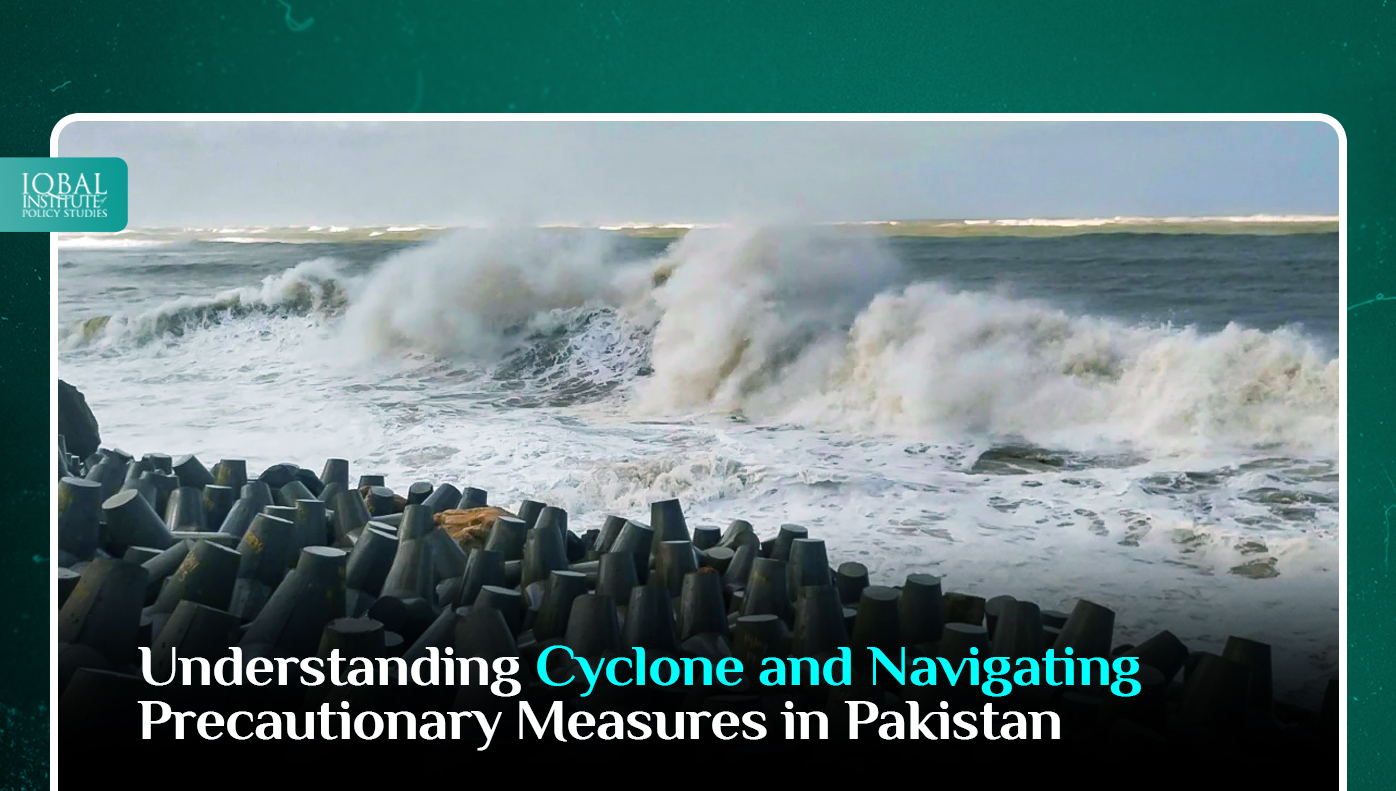Cyclones are natural disasters that bring forth immense destruction, leaving devastation in their wake. While Pakistan may not be commonly associated with cyclones, however, this time, the country is at serious risk of bracing cyclone biparjoy. In these circumstances, residents must be aware of these formidable weather systems and the precautions required to minimise their impact. This blog of the Iqbal Institute of Policy Studies (IIPS) will explore the cyclone’s impact in Pakistan and highlight the crucial steps individuals and communities can take to prepare for and mitigate the consequences of these powerful storms.
Understanding Cyclone
Cyclones, hurricanes or typhoons are large-scale weather systems characterised by a low-pressure centre surrounded by strong winds and thunderstorms. They derive energy from warm ocean waters and typically develop in tropical regions. Cyclones are classified based on intensity, and the Saffir-Simpson Hurricane Wind Scale is commonly used to gauge their strength. The impacts of cyclones can be far-reaching, including heavy rainfall, storm surges, strong winds, and potential flooding.
Cyclone Biparjoy
According to Pakistan’s National Disaster Management Authority (NDMA), a severe cyclonic storm called “Biparjoy” is expected to hit Pakistan’s Southern parts on Thursday with maximum winds over 124 mph. Experts estimated that the cyclone has extremely damaging potential. As per the ongoing situation, the government has ordered the evacuation of people living near the coastline. After the declaration of emergency, around 80,000 people had been evacuated and moved to a safer place on higher ground.
It is considered to be the first severe cyclone after last year’s catastrophic flooding that caused widespread destruction. Experts have forecasted that this storm will cause flooding, affecting as many as Experts have warned that with this storm forecast to hit highly populated areas, as many as a third of Pakistan’s 247 million people, including in areas still recovering from the impact of last year’s inundations.
Precautionary Measures
Stay Informed
Regularly monitor weather forecasts and updates from reliable sources such as the Pakistan Meteorological Department (PMD) or local authorities. Pay close attention to cyclone warnings, track predictions, and evacuation advisories to ensure you have the latest information.
Develop an Emergency Plan
Prepare an emergency plan for your family or community. Identify safe evacuation routes, establish meeting points, and designate a point of contact. Ensure that everyone knows the plan and practices it periodically to familiarize yourselves with the necessary steps.
Assemble an Emergency Kit
Put together a well-stocked emergency kit that includes essential supplies such as non-perishable food items, drinking water, a first aid kit, flashlights, batteries, a portable radio, necessary medications, and important documents. Store the kit in a readily accessible location.
Secure Your Property
Reinforce doors, windows, and roofs to make them more resilient to strong winds. Clear your surroundings of loose objects that can become projectiles during a cyclone. Trim tree branches that may pose a risk of falling and causing damage.
Evacuation Planning
If advised to evacuate, follow the instructions promptly. Pack necessary items from your emergency kit, secure your home, and move to a designated evacuation centre or a safe location on higher ground. Be prepared for potential road closures and congestion, and plan alternative routes in advance.
Stay Safe Indoors
If evacuation is not required, stay indoors during the cyclone. Choose an interior room away from windows, preferably on a lower floor. Listen to weather updates, and avoid using electrical appliances or landline phones during the storm to reduce the risk of electrocution.
Post-Cyclone Safety
Be cautious even after the cyclone has passed. Watch out for downed power lines, fallen debris, and flooding. Do not attempt to wade or drive through floodwaters, as they may be deeper or more dangerous than they appear.
Conclusion
In conclusion, understanding cyclones and implementing preventive measures are of paramount importance in Pakistan. The country’s geographical location, with its proximity to the Arabian Sea and the presence of the Indus River, makes it susceptible to cyclonic activities. Throughout this blog, we have explored different aspects of cyclones like their definition, intensity, impacts on Pakistan and precautionary measures that can be taken to minimise disasters. It is crucial for the government, disaster management authorities, and communities to work together to create awareness and develop robust systems for cyclone preparedness. This includes investing in early warning systems, improving communication networks, and establishing evacuation plans that take into account the unique needs and vulnerabilities of different regions.
This article is written by Radma Nouman. Radma is a Research Analyst at the Iqbal Institute of Policy Studies (IIPS).



Leave a Reply